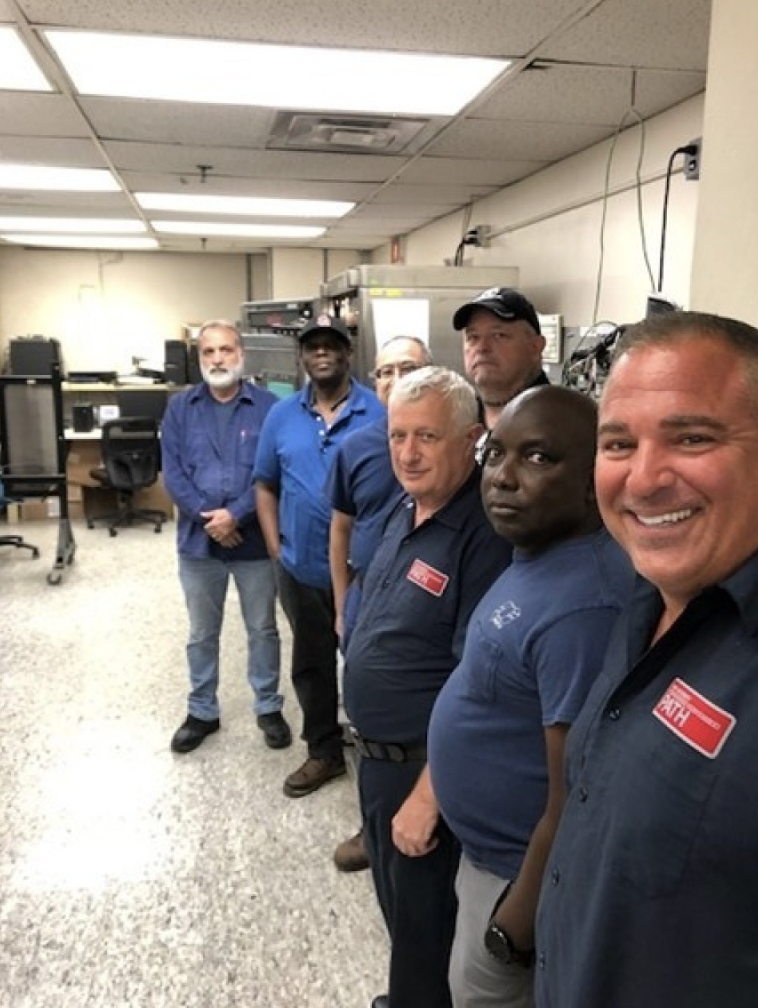
To Fight Fare Evasion, PATH Turnstiles ‘Speak Up’
Written by Nebraska Digital, administrator
Eugene Shnayderman (left) and PATH Chief Maintenance Supervisor Charles Chipman standing guard. (PANY/NJ Photograph)
On their shared daily train ride to PATH headquarters in Jersey City, N.J., electronic technicians Rondell Benjamin and Eugene Shnayderman were often frustrated by the fare evasion they routinely witnessed during their commute. Shnayderman decided to do something about it.
During his off-duty time at home, Shnayderman came up with one solution to help deter fare evaders—a mini-circuit board that plugs into a turnstile—by triggering warnings for those who attempt to evade fare payment. They have been installed on the gates that accommodate customers with mobility issues by opening and closing more slowly than other PATH turnstiles to enable easier access. These so-called ADA (Americans with Disabilities Act) gates are the most susceptible to breaches and where most PATH fare evasion occurs.
“Eugene’s background in radio technology and the military allows him to look at solving problems with limited funds and daunting physical challenges,” said Joy Chiu, the superintendent of PATH’s Structures and Facilities Division. “He came up with a creative way to add to what is available and built an interface that works.’’
Shnayderman’s invention sets off a flashing red light and an audible “Pay first!” warning when riders pass an ADA gate threshold without paying. If that doesn’t do the trick and the evader pushes forward, a second message alert calls out, “Violation, you didn’t pay, violation,” as the light continues to flash. That language also serves as a legal warning to violators that they could be ticketed for their actions. Depending on the state where the fare evasion occurred, fines could range from $50 to $250.

Shnayderman’s work is part of PATH’s plan to address the problem of fare evasion, which afflicts virtually every transit agency across the United States. PATH began rolling out voice-response fare evasion messages earlier this year with a pilot at Journal Square. It’s now in place at all stations.
PATH has increased the number and frequency of public service announcements at its stations, warning violators of summonses if they don’t pay. It also is exploring enforcement and equipment adjustments to help stem the estimated loss of millions of dollars in revenue each year.
Shnayderman is a member of the team at a busy technology and repair laboratory in Journal Square, where an electronic technicians group led by Benjamin and supported by 13 machine repair mechanics is tasked with maintaining equipment at PATH stations. One of their persistent challenges is fabricating parts that are no longer available from the manufacturer or too expensive to purchase new, which is why the laboratory is always teeming with circuit boards, wiring spools, batteries, tool kits, and other essential tools of the trade.
The people who work in our maintenance facilities pull off small miracles on a regular basis. This is a great example of the kinds of ingenuity we continually see from our team.
PATH Director/General Manager Clarelle DeGraffe
The work of Shnayderman and the staff to keep a 100-plus-year-old railroad operating smoothly is extraordinary and a tribute to the team’s innovative spirit and commitment to public service, said PATH Facilities Superintendent Chiu.
For Shnayderman, it’s about fairness and doing what’s right. He believes that fare evaders sometimes just need a good talking to—literally. “You come to a restaurant; do you pay for what you eat? Of course, you do,” he said. “It’s the same thing here. We’re providing a service and people need to pay.”
Shnayderman was born in Belarus and learned his engineering trade in Lithuania before emigrating to the United States. He worked at the MTA in communications security, eventually moving to PATH for an opportunity to take on more challenging assignments. With the voice-activated deterrence system, he’s checked a big box on PATH’s innovation list.
“A lot of employees have great ideas, it just takes encouragement from management to give it a try,” Chiu said. “That was the case here.”
This article first appeared on the Now Arriving section of the PA/NYNJ website.



